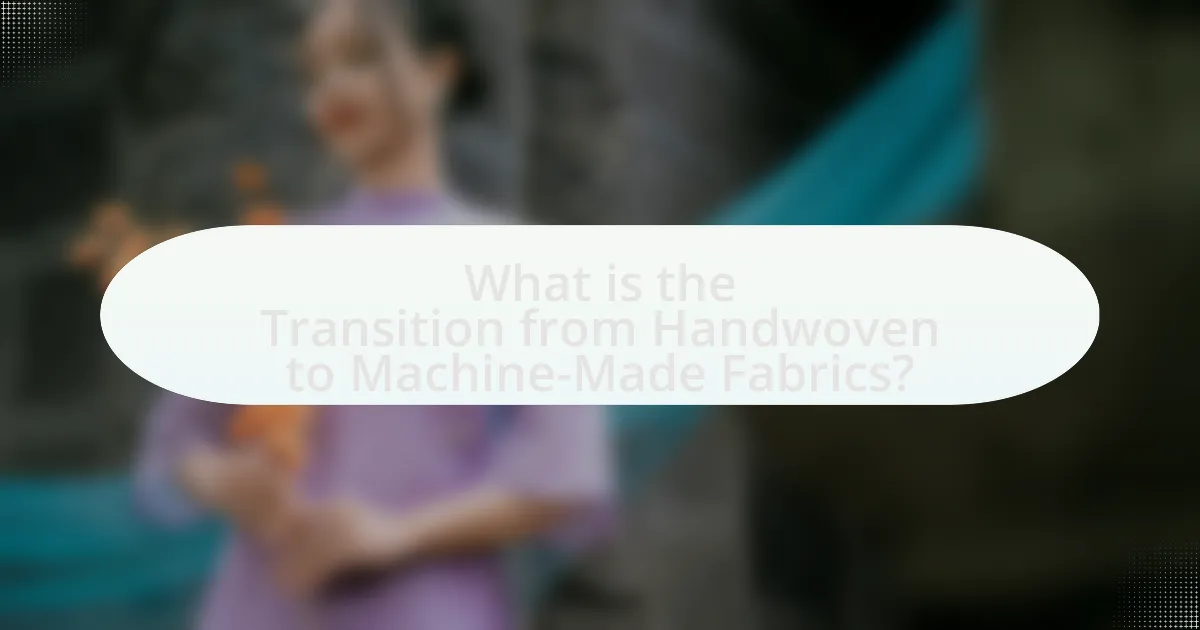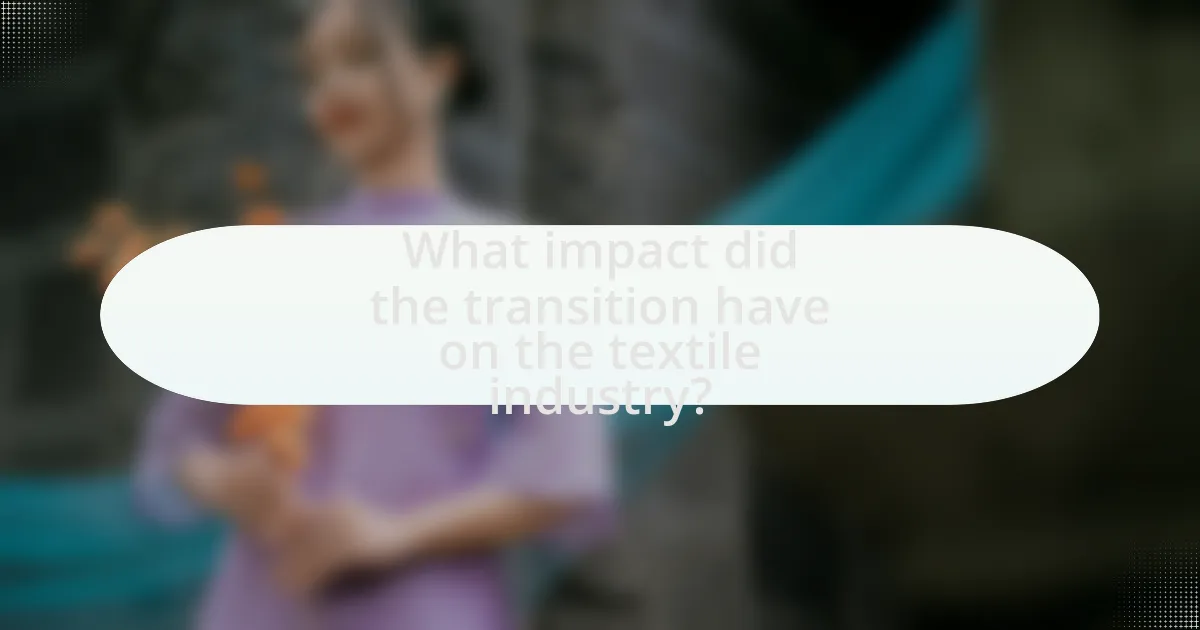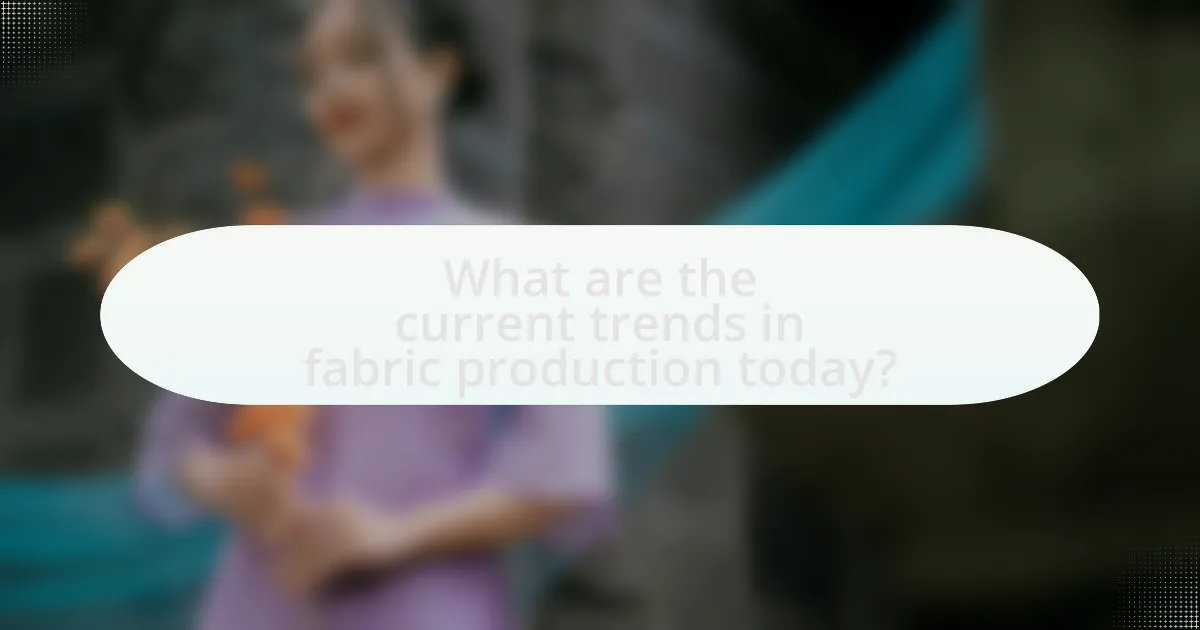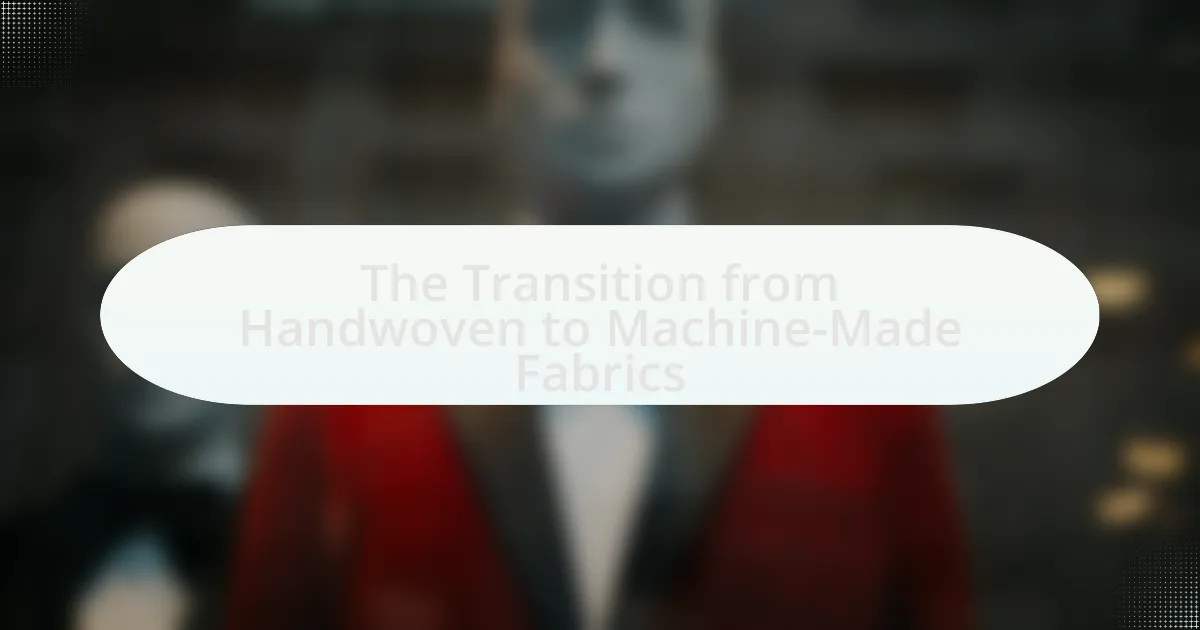The article examines the transition from handwoven to machine-made fabrics, a significant shift in textile production that began during the Industrial Revolution. It details the historical evolution of handwoven fabrics, traditional weaving techniques, and the cultural influences that shaped their styles. The article contrasts the production processes, quality differences, and economic factors influencing the rise of machine-made fabrics, highlighting the impact on employment and consumer preferences. Additionally, it addresses environmental implications and current trends in fabric production, including sustainable practices and technological innovations.

What is the Transition from Handwoven to Machine-Made Fabrics?
The transition from handwoven to machine-made fabrics involves a significant shift in textile production methods, primarily driven by the Industrial Revolution in the 18th and 19th centuries. This transition marked the move from labor-intensive, artisanal weaving techniques to automated processes that increased efficiency and production scale. Machine-made fabrics, produced using power looms and other machinery, allowed for mass production, reduced costs, and greater consistency in quality. Historical data indicates that by the mid-19th century, machine-made textiles dominated the market, leading to a decline in traditional handweaving practices. This shift not only transformed the textile industry but also had broader economic and social implications, including changes in labor dynamics and consumer accessibility to fabrics.
How did handwoven fabrics originate and evolve over time?
Handwoven fabrics originated around 5000 BCE, with early examples found in ancient civilizations such as Mesopotamia and Egypt, where people used simple looms to create textiles from natural fibers like wool, linen, and cotton. Over time, the techniques for weaving evolved, leading to more complex patterns and the introduction of dyes, which enhanced the aesthetic appeal of fabrics. By the Middle Ages, handwoven textiles became integral to trade, with regions specializing in specific types of fabrics, such as silk in China and wool in Europe. The Industrial Revolution in the 18th century marked a significant turning point, as mechanized looms began to replace handweaving, drastically increasing production speed and reducing costs. This transition led to the widespread availability of fabrics, fundamentally changing the textile industry and consumer habits.
What techniques were traditionally used in handweaving?
Traditionally, handweaving techniques included plain weave, twill weave, and satin weave. Plain weave, the simplest technique, involves alternating the warp and weft threads, creating a tight and durable fabric. Twill weave, characterized by its diagonal pattern, allows for more complex designs and greater drape, while satin weave produces a smooth, glossy surface by floating the weft threads over multiple warp threads. These techniques have been foundational in textile production, with historical evidence showing their use in various cultures for centuries, such as the use of plain weave in ancient Egyptian linen and twill in medieval European textiles.
How did cultural influences shape handwoven fabric styles?
Cultural influences significantly shaped handwoven fabric styles by dictating patterns, colors, and techniques that reflect the values and traditions of specific communities. For instance, indigenous cultures often incorporated symbols and motifs that represent their beliefs, such as the use of geometric patterns in Navajo textiles, which convey spiritual meanings. Additionally, regional resources, such as local dyes and fibers, influenced the aesthetic and functional aspects of the fabrics, leading to unique styles that are emblematic of their cultural origins. Historical trade routes also played a role, as they facilitated the exchange of ideas and techniques, resulting in hybrid styles that blended different cultural elements, such as the fusion of Persian and Indian weaving techniques in the production of carpets.
What are the key differences between handwoven and machine-made fabrics?
Handwoven fabrics are created manually using traditional techniques, while machine-made fabrics are produced using automated processes. Handwoven fabrics often exhibit unique textures and patterns due to the artisan’s skill and the variability of manual weaving, whereas machine-made fabrics are typically uniform and consistent in texture and design due to the precision of machinery. Additionally, handwoven fabrics tend to be more expensive and time-consuming to produce, reflecting the craftsmanship involved, while machine-made fabrics are generally more affordable and produced at a faster rate, catering to mass markets.
How does the production process differ between the two types of fabrics?
The production process of handwoven fabrics differs significantly from that of machine-made fabrics in terms of technique and efficiency. Handwoven fabrics are created using traditional looms operated manually, which allows for intricate designs but results in slower production rates, often taking hours or days to complete a single piece. In contrast, machine-made fabrics utilize automated looms that can produce large quantities of fabric in a fraction of the time, often within minutes, while maintaining uniformity and consistency in texture and design. This shift to machine production has revolutionized the textile industry, enabling mass production and reducing costs, as evidenced by the fact that machine-made fabrics account for over 90% of global fabric production today.
What are the quality differences between handwoven and machine-made fabrics?
Handwoven fabrics typically exhibit superior quality compared to machine-made fabrics due to their craftsmanship and material integrity. Handwoven fabrics are often made from higher-quality fibers and involve meticulous attention to detail, resulting in unique textures and patterns that are difficult to replicate by machines. In contrast, machine-made fabrics are produced in bulk, which can lead to inconsistencies in quality, such as uneven weaves and lower durability. Studies indicate that handwoven textiles can last significantly longer than their machine-made counterparts, as the weaving process allows for greater strength and resilience in the fabric structure.
Why did the transition to machine-made fabrics occur?
The transition to machine-made fabrics occurred primarily due to the Industrial Revolution, which introduced mechanized production methods that significantly increased efficiency and reduced costs. The invention of machines like the spinning jenny and power loom allowed for faster and more consistent fabric production compared to traditional handweaving. By the early 19th century, factories began to dominate textile manufacturing, leading to mass production capabilities that met growing consumer demand. This shift was further supported by advancements in technology and the availability of raw materials, which made machine-made fabrics more accessible and affordable for the general population.
What technological advancements facilitated this transition?
The technological advancements that facilitated the transition from handwoven to machine-made fabrics include the invention of the power loom and the spinning jenny. The power loom, developed by Edmund Cartwright in 1785, automated the weaving process, significantly increasing production speed and efficiency compared to manual methods. The spinning jenny, invented by James Hargreaves in 1764, allowed a single worker to spin multiple spools of thread simultaneously, enhancing yarn production. These innovations led to the establishment of textile factories, which centralized production and reduced labor costs, ultimately transforming the fabric industry.
How did economic factors influence the shift to machine-made fabrics?
Economic factors significantly influenced the shift to machine-made fabrics by driving down production costs and increasing efficiency. The Industrial Revolution introduced mechanized looms and spinning machines, which allowed for mass production of textiles at a fraction of the cost of handwoven fabrics. For instance, the introduction of the power loom in the early 19th century enabled manufacturers to produce fabric much faster, reducing labor costs and increasing output. This shift was further supported by the growing demand for affordable clothing during urbanization, as more people moved to cities and sought inexpensive textiles. Consequently, the economic imperative for lower prices and higher production rates led to the widespread adoption of machine-made fabrics over traditional handwoven methods.

What impact did the transition have on the textile industry?
The transition from handwoven to machine-made fabrics significantly increased production efficiency and reduced costs in the textile industry. This shift allowed manufacturers to produce larger quantities of fabric in shorter timeframes, leading to a dramatic rise in output. For instance, the introduction of the power loom in the early 19th century enabled factories to produce textiles at a rate that handweaving could not match, resulting in a tenfold increase in fabric production. Additionally, machine-made fabrics became more affordable, making textiles accessible to a broader consumer base and stimulating demand. This transition also led to the decline of traditional handweaving practices and the rise of factory-based labor, fundamentally altering the workforce dynamics within the industry.
How did the transition affect employment in the textile sector?
The transition from handwoven to machine-made fabrics significantly reduced employment in the textile sector. As mechanization increased efficiency and production capacity, the demand for skilled handweavers diminished, leading to widespread job losses. For instance, during the Industrial Revolution, it is estimated that the introduction of power looms displaced thousands of artisans, as factories could produce textiles at a fraction of the cost and time compared to traditional methods. This shift not only transformed the labor landscape but also contributed to the rise of factory-based employment, which often involved lower wages and poorer working conditions compared to artisanal weaving.
What types of jobs were created or lost during this transition?
During the transition from handwoven to machine-made fabrics, many jobs were lost in traditional weaving and artisanal textile production. Specifically, skilled handweavers and craftspeople faced significant unemployment as mechanization reduced the demand for their labor. Conversely, new jobs were created in textile manufacturing facilities, including positions for machine operators, maintenance workers, and factory supervisors. This shift resulted in a net loss of skilled labor positions while increasing opportunities in industrial settings, reflecting a broader trend of job displacement due to technological advancement in the textile industry.
How did skill requirements change with the introduction of machine-made fabrics?
The introduction of machine-made fabrics significantly reduced the skill requirements for textile production. Prior to mechanization, weaving and fabric production demanded extensive manual skills, including intricate techniques and craftsmanship. With the advent of machines like the power loom in the early 19th century, the process became more standardized and efficient, allowing unskilled laborers to operate machinery with minimal training. Historical data indicates that the number of skilled weavers declined sharply as factories prioritized speed and volume over artisanal quality, leading to a workforce that was predominantly composed of less skilled laborers. This shift not only transformed the labor market but also altered the nature of textile production, emphasizing quantity over craftsmanship.
What environmental implications arose from the shift to machine-made fabrics?
The shift to machine-made fabrics has led to significant environmental implications, primarily increased pollution and resource depletion. Machine production processes often rely on synthetic fibers, such as polyester, which are derived from petroleum, contributing to fossil fuel consumption and greenhouse gas emissions. Additionally, the manufacturing of these fabrics generates substantial wastewater and chemical runoff, which can contaminate local water sources. For instance, the textile industry is responsible for about 20% of global water pollution, as reported by the United Nations Environment Programme. Furthermore, the mass production of machine-made fabrics encourages fast fashion, resulting in increased textile waste, with an estimated 92 million tons of waste generated annually from discarded clothing.
How does the production of machine-made fabrics compare environmentally to handwoven fabrics?
The production of machine-made fabrics generally has a greater environmental impact compared to handwoven fabrics. Machine-made fabrics often require significant energy consumption, primarily from fossil fuels, leading to higher carbon emissions. In contrast, handwoven fabrics typically utilize less energy, as they are produced manually and often use natural fibers, which have a lower environmental footprint. Additionally, the mass production of machine-made fabrics can lead to increased waste and pollution from dyes and chemicals, whereas handwoven fabrics tend to have a more sustainable production process with fewer harmful byproducts.
What sustainability practices have emerged in response to machine-made fabric production?
Sustainability practices that have emerged in response to machine-made fabric production include the use of organic materials, recycling initiatives, and the adoption of eco-friendly manufacturing processes. Organic materials, such as organic cotton and hemp, reduce the environmental impact by minimizing pesticide use and promoting biodiversity. Recycling initiatives, like fabric recycling programs, aim to reduce textile waste by repurposing discarded fabrics into new products. Additionally, eco-friendly manufacturing processes, such as waterless dyeing technologies and energy-efficient machinery, significantly lower the carbon footprint associated with fabric production. These practices collectively address the environmental challenges posed by traditional machine-made fabric production.
How did consumer preferences change as a result of this transition?
Consumer preferences shifted significantly towards machine-made fabrics due to their affordability, consistency, and availability. As machine production increased, consumers began to favor lower-priced textiles that offered uniform quality over the artisanal appeal of handwoven options. This transition was driven by the Industrial Revolution, which made mass production possible, resulting in a dramatic decrease in fabric costs. For instance, by the mid-19th century, machine-made fabrics became widely accessible, leading to a surge in demand as consumers prioritized practicality and cost-effectiveness over traditional craftsmanship.
What factors influenced consumer acceptance of machine-made fabrics?
Consumer acceptance of machine-made fabrics was influenced by factors such as affordability, consistency in quality, and the convenience of mass production. The introduction of machine-made fabrics significantly reduced production costs, making these textiles more accessible to a broader audience. Additionally, machine-made fabrics offered uniformity in texture and appearance, which appealed to consumers seeking reliability in their purchases. The convenience of availability in various styles and colors further enhanced consumer acceptance, as it allowed for easier integration into everyday fashion. Historical data indicates that during the Industrial Revolution, the shift to machine production led to a dramatic increase in fabric availability, which directly correlated with rising consumer demand for these products.
How has the perception of quality evolved with the rise of machine-made fabrics?
The perception of quality has shifted significantly with the rise of machine-made fabrics, moving from an emphasis on artisanal craftsmanship to a focus on uniformity and affordability. Historically, handwoven fabrics were valued for their unique textures and the skill involved in their creation, leading consumers to associate quality with the labor-intensive process. However, the introduction of machine-made fabrics in the 19th century allowed for mass production, resulting in consistent quality and lower prices, which appealed to a broader market. This transition has led to a dual perception: while some consumers still value the uniqueness of handwoven textiles, many now prioritize the accessibility and durability of machine-made options, reflecting a broader societal shift towards convenience and cost-effectiveness in textile consumption.

What are the current trends in fabric production today?
Current trends in fabric production include the increasing use of sustainable materials, advancements in technology for automation, and a shift towards digital printing techniques. Sustainable materials, such as organic cotton and recycled polyester, are gaining popularity due to rising consumer demand for eco-friendly products. Automation technologies, including computer-controlled looms and robotic sewing machines, enhance efficiency and reduce labor costs. Additionally, digital printing allows for more intricate designs and shorter production runs, catering to fast fashion’s need for rapid turnaround times. These trends reflect the industry’s adaptation to environmental concerns and consumer preferences for customization and speed.
How are modern technologies reshaping fabric production?
Modern technologies are reshaping fabric production by integrating automation, digital printing, and advanced materials, which enhance efficiency and customization. Automation in weaving and knitting processes significantly reduces labor costs and production time, allowing for mass production of fabrics. Digital printing technology enables intricate designs to be printed directly onto fabrics, minimizing waste and allowing for on-demand production. Additionally, the development of smart textiles, which incorporate sensors and electronics, expands the functionality of fabrics beyond traditional uses. These advancements collectively lead to a more sustainable and versatile fabric production landscape.
What role does automation play in contemporary fabric manufacturing?
Automation plays a crucial role in contemporary fabric manufacturing by significantly enhancing production efficiency and consistency. Automated processes, such as computer-controlled weaving and knitting machines, allow manufacturers to produce large quantities of fabric with precision and reduced labor costs. For instance, the use of automated cutting machines can increase fabric yield and minimize waste, leading to more sustainable practices. Additionally, automation facilitates faster turnaround times, enabling manufacturers to respond swiftly to market demands. According to a report by the International Textile Manufacturers Federation, automation in textile production can increase output by up to 30%, demonstrating its impact on the industry’s productivity and competitiveness.
How are digital technologies influencing design and production processes?
Digital technologies are significantly influencing design and production processes by enabling automation, enhancing precision, and facilitating rapid prototyping. Automation through computer-aided design (CAD) and computer numerical control (CNC) machines allows for faster production cycles and reduces human error, leading to higher quality outputs. For instance, the use of CAD software in textile design allows designers to create intricate patterns and simulations that can be easily modified, streamlining the design phase. Additionally, digital printing technologies have revolutionized fabric production by allowing for on-demand printing, which minimizes waste and inventory costs. According to a report by Smithers Pira, digital textile printing is expected to grow at a compound annual growth rate of 20% from 2020 to 2025, highlighting its increasing adoption in the industry. This integration of digital technologies not only enhances efficiency but also fosters innovation in fabric design and production methods.
What are the emerging alternatives to traditional fabric production methods?
Emerging alternatives to traditional fabric production methods include 3D knitting, biofabrication, and digital printing. 3D knitting allows for the creation of complex textile structures without the need for cutting and sewing, significantly reducing waste. Biofabrication utilizes living organisms, such as bacteria and fungi, to produce materials that mimic traditional fabrics, offering a sustainable option. Digital printing enables precise designs to be printed directly onto fabrics, minimizing water usage and chemical waste compared to conventional dyeing processes. These methods are gaining traction due to their potential for sustainability and efficiency in the textile industry.
How are sustainable practices being integrated into fabric production?
Sustainable practices are being integrated into fabric production through the adoption of eco-friendly materials, energy-efficient manufacturing processes, and waste reduction strategies. For instance, many manufacturers are now using organic cotton, recycled polyester, and other sustainable fibers that minimize environmental impact. Additionally, advancements in technology have led to the implementation of energy-efficient machinery that reduces water and energy consumption during production. According to a report by the Textile Exchange, the use of recycled fibers can significantly lower greenhouse gas emissions, demonstrating the effectiveness of these sustainable practices in reducing the overall carbon footprint of fabric production.
What innovations are being explored in the realm of fabric materials?
Innovations in fabric materials include the development of smart textiles, sustainable fabrics, and bioengineered materials. Smart textiles incorporate technology to provide functionalities such as temperature regulation and moisture management, enhancing user comfort and performance. Sustainable fabrics focus on reducing environmental impact through the use of recycled materials and eco-friendly production processes, addressing the growing demand for environmentally responsible fashion. Bioengineered materials, such as lab-grown leather and plant-based fibers, offer alternatives to traditional textiles, promoting ethical consumption and reducing reliance on animal products. These innovations reflect a significant shift in the fabric industry towards more advanced, sustainable, and functional materials.
What practical tips can consumers consider when choosing between handwoven and machine-made fabrics?
Consumers should consider the intended use, durability, and aesthetic appeal when choosing between handwoven and machine-made fabrics. Handwoven fabrics often offer unique textures and patterns, making them ideal for decorative purposes or special occasions, while machine-made fabrics typically provide greater consistency and durability for everyday use. Additionally, consumers should evaluate the environmental impact; handwoven fabrics may be more sustainable due to lower energy consumption in production. Lastly, price is a significant factor, as handwoven fabrics tend to be more expensive due to the labor-intensive process, whereas machine-made options are generally more affordable.

Leave a Reply